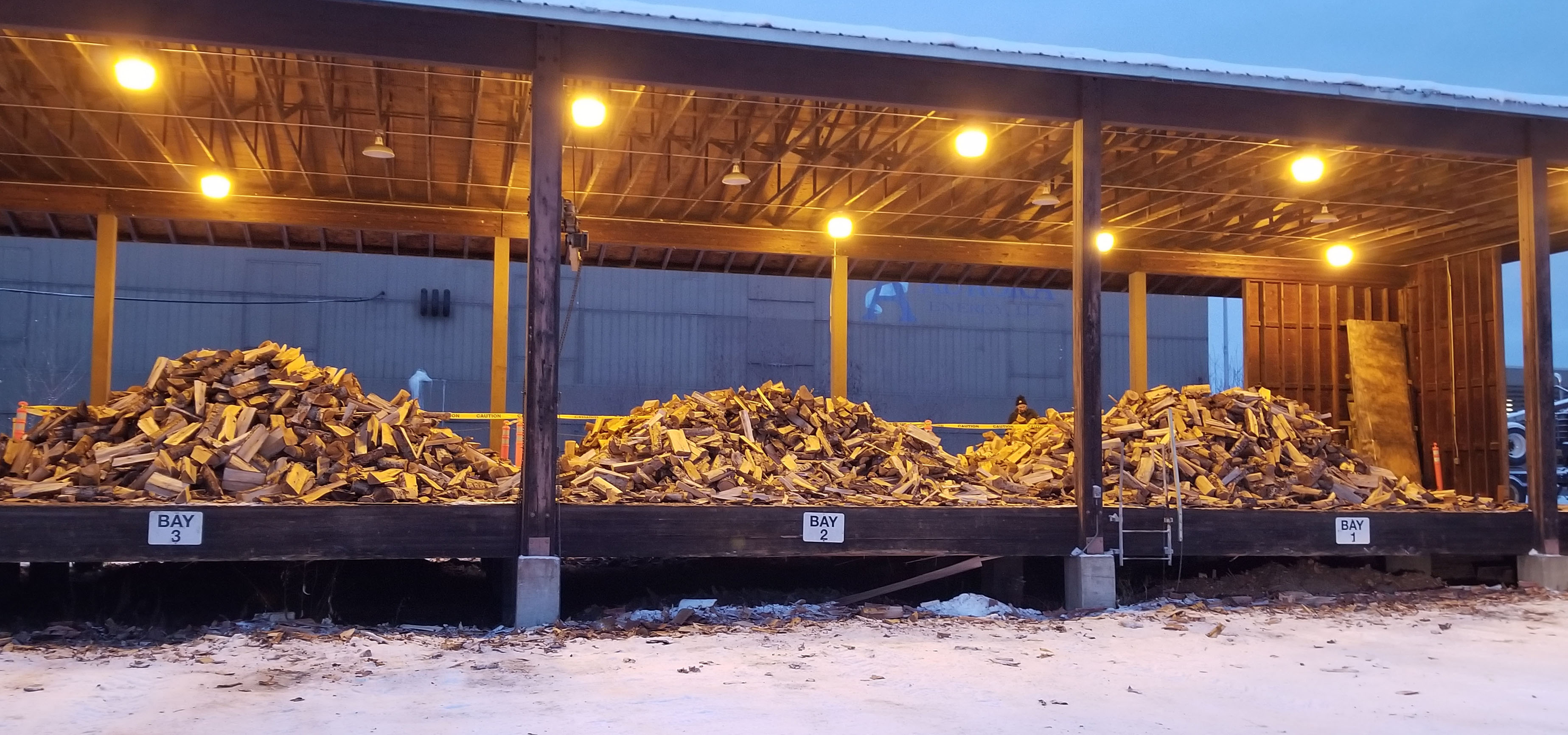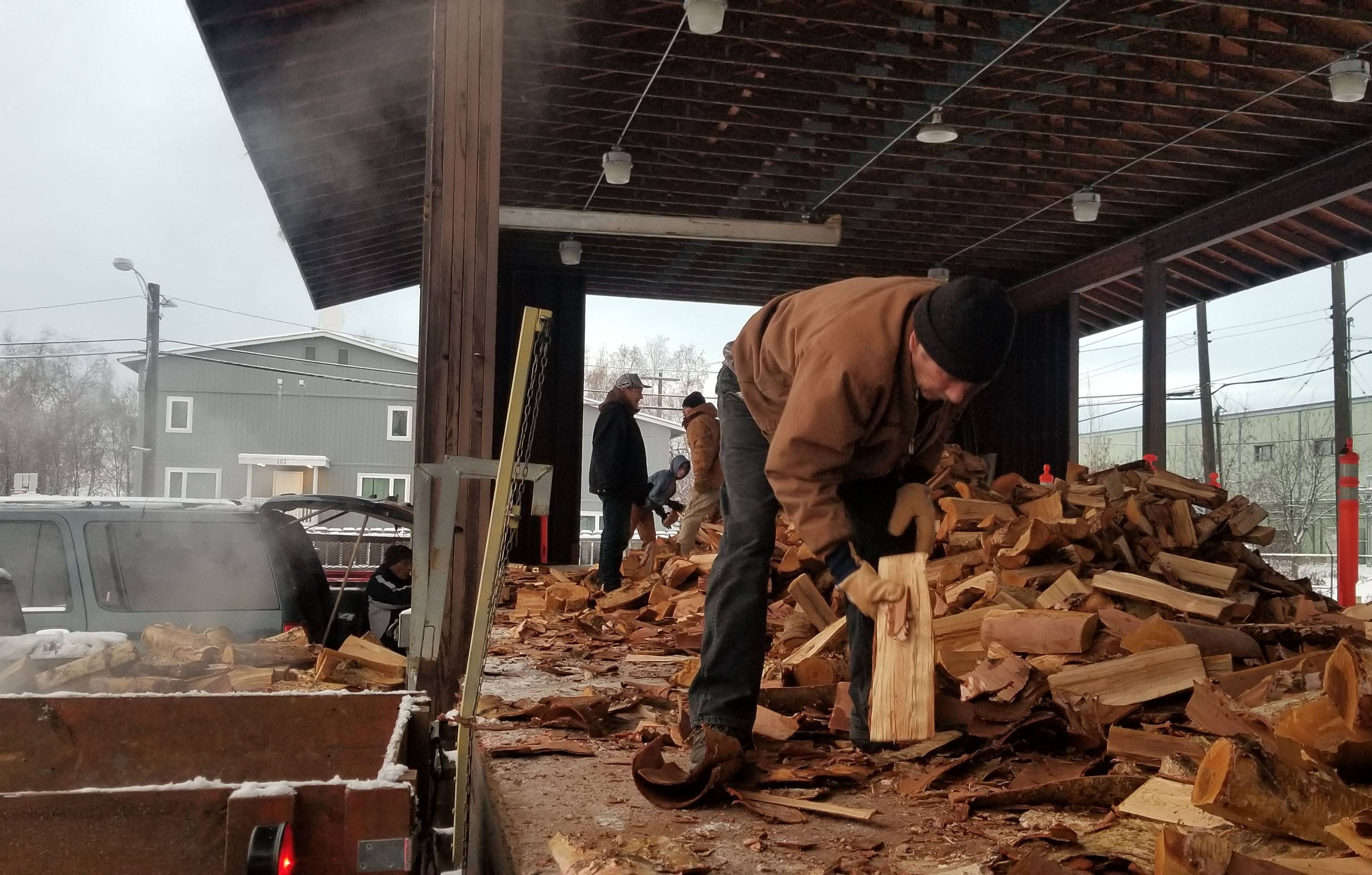Dropping in for dry wood

Three piles of wood, around six cords, sit on the 150-foot-long wood platform, ready to load into vehicles.
At 9 a.m. on a crisp Monday morning in mid-November, I am one of about 10 people standing outside an office on First Avenue in Fairbanks. We are here for the “wood drop” program organized by Aurora Energy Solutions, a subsidiary of Aurora Energy — the company that owns the 27.5-megawatt coal-fired power plant, right across the road, that supplies electricity to the greater Fairbanks area and heat in the form of steam to the downtown area.
I walk inside and sign the roster of wood buyers. I am fifth on the list. I make small talk with the others standing around, trying to glean information not only about why they are here but also how this works. One man tells me that I am after the white pickup with the trailer. I think that is very kind and I politely stand around waiting for my next instructions. I notice another vehicle pull behind the trailer. I quietly amble to my vehicle and quickly drive it out of the office parking lot and behind the next vehicle. I notice a line of cars already snaking around the corner onto Second Avenue behind the building. More vehicles are arriving and stopping in line. The instructions for this event are not going to just present themselves. I feel like we are in the Wild West.
By 10 a.m., around 30 vehicles ranging from full size pickup trucks to Subaru Foresters line up around the corner to get into the gated wood-loading area, their drivers ready to hand-load wood into the truck beds. Some vehicles have passengers ready to help load wood, too. Right at 10 a.m., the gates open, and as many vehicles as can safety fit in do so.

A man picks dry wood and loads it into his truck.
When I enter, six trucks are backed up to a huge, covered metal platform that’s about 150 feet long. The split, dry wood is dropped onto this platform, hence the name “wood drop,” and it offers a perfect way for people to load their vehicles without breaking their backs.
One truck leaves, opening the space for my out-of-place Subaru — it is Fairbanks, though, so is a Subaru actually ever out of place? I back in almost to the platform, knowing I need to open my hatch and load from the ground.
It is not, as you might imagine, a free-for-all wood-chucking event. Well, it kind of is. But, as I haphazardly load my Subaru, I begin to observe there may be an art to this. My neighbor, Matt, is picking through the wood rather than just throwing randomly like I am. He says he is picking the right-sized pieces so he doesn’t have to split the wood further when he gets home. I start to take note and think about the size of my own wood-burning device. I get a little pickier.
Most trucks have a beautifully orderly load of wood, arranged so it is flat across the bed and running just to below of the truck bed sides. This is where the second person comes in handy. My mountain of wood is uneven and also sitting on top of my skis, but I won’t find that out until later when I am running late to my ski class. The wood is, I find out, measured after loading and charged per volume. There’s good monetary reasons to pack it in neat and tight.
Matt is visiting the wood drop for only his third time. He normally harvests his own wood, but a recent second-story addition to his house means he now needs twice the amount of wood as he previously did.

Brian Meyer from Aurora Energy Solutions measures the mountain of wood in my Subaru.
Susan Shopper, general manager of Aurora Energy Solutions, says there are many repeat customers, because either they can only haul so much wood per trip or they have wood storage space limitations. In the summer months, the number of weekly wood drop attendees decreases to around a dozen.
After loading the amount of wood I feel a Subaru can safely carry, I go back to the front office, where Brian Meyer, the AES sales associate, comes out with a measuring tape to estimate the volume of my mountain. I now see the value of careful placement. My total is $43.37. Not bad. This amount of wood will heat my sauna for a while.
“A cord of firewood stacked is 128 cubic feet or loose is 180 cubic feet,” said Shopper. “We sell a full cord for $405. If purchased in partial volume, the price is closer to $480 per cord.”
“Our wood drop customer count during this time of year is close to 30 per wood drop,” said Shopper. “Depending on the kiln cycle times, we will do one to two wood drops per week.”
Drying it out
Like most power plants, heat is generated during the production of electricity, and Aurora Energy Solutions recently employed some of that extra heat to dry birch wood for residential use. If you have seen that building on Phillips Field Road that looks like it’s billowing smoke — that is the kiln.
Shopper explained the kiln and wood-drying process in an email to me. “The process is an indirect-fired system utilizing steam produced from the power plant across the river. This is the main reason why our firewood processing location is located so close to downtown.”
Inside the kiln, Shopper explains, seven fans blow air over the closed-loop steam coils to capture heat. The steam will condense and return to the power plant. Each cord of firewood will be dried to 20% or less moisture content — the amount of water displaced for each cord of firewood is 175 gallons, or 1,400 pounds.
The weight of a dry cord of wood — cords are a measured unit 4 feet by 4 feet by 8 feet —weighs around 2,500 pounds. Think of the added moisture in wet wood.
The drying duration can vary from 48 to 96 hours, depending on the ambient temperature and how recently the birch was harvested. “This fall, we were processing birch within days of it being harvested, and water would drip out of the logs during the cutting and splitting process,” said Shopper.
During the colder months, the moisture in the logs is frozen. “The steam we supply is 230ºF, it can take over a day at this temperature for the wood to thaw, and then a few days to dry to less than 20% moisture. Once the wood is 200ºF, we maintain that temperature for 24 hours and pull the firewood to sell. Our kiln holds 48 cords.” Shopper adds that they have a second kiln ordered and hope to have it operating in the late fall of 2023.
Dry wood and air quality
I, like many people I am sure, attended the wood drop because there is limited availability of dry wood in Fairbanks. There are six companies listed on the Alaska Department of Environmental Conservation Division of Air Quality website. This page lists the companies in the state that sell certified “dry” wood with a moisture content of 20% or lower. The page also has a lot of very useful information on drying and storing wood. That percentage and lower has been determined to be better for air quality, especially particulate matter in the 2.5 micron range (PM2.5). This is the size of particle that can be breathed into the lungs and cause respiratory illness.
“Burning wet wood produces more smoke and PM2.5 than burning dry wood,” said ACEP research assistant professor Dominique Pride. “It also is more expensive to burn wet wood because it doesn't burn as hot so you must burn more wood. Firewood should have 20% or less moisture content.”
Pride is leading an air quality research project looking at the reduction of PM2.5 in the North Pole area. She is hoping to test the use of electric thermal storage heaters in place of wood stoves. The program is currently installing weather stations and conducting preliminary data collection for the program.
Aurora Energy Solutions was formed to grow the availability of clean-burning solid fuels. “The decision was motivated by numerous factors,” explained Shopper. “Including air quality issues, quality control for wood-based fuels, local job creation, and local resource utilization.” She adds that the firewood kiln operation addresses all those factors while also complying with the constantly evolving air quality regulations in the Fairbanks community.
“It’s really a win-win for the community when the private sector steps up and does something like this,” said Nick Czarnecki, program manager for the Alaska DEC Air Quality Division in Fairbanks. “Dry wood actually really does benefit the airshed, because when you burn drier wood, you have less moisture content in it.”
Czarnecki adds that you’re going to get more heat in the house because you will use less energy to boil off and burn that water. “It’s pretty substantial.” He said that the air quality team went through a cost-benefit analysis in 2018 and found “if you could replace all of the commercially sold dry wood in the nonattainment area with dry wood that is to the standards that the kiln produces, then it could net a substantial emissions decrease — somewhere around 5-7 percent.” That is definitely a benefit to the community.
With temperatures dropping, more Fairbanksans are thinking about heating their homes, and with the high cost of heating fuel, wood is a great choice. The air quality forecast is currently good for the next couple of days; however, cold weather and a strong temperature inversion could change that.
I know I will be back for another shot at the wood drop. The website says there is still wood available, and I know I will want a hot sauna when the unusually warm November temperatures drop down to the usual very small — or very large — negative digits. I drive back down to the wood drop area, sign in and this time I am the only vehicle backed up to the platform. There are three large mounds of wood, and this time I mindfully move my skis out of the way this time and place the wood in piece by piece, sorting through for sizes that won’t need extra work at home. The Subaru is starting to feel more like a truck, and I am starting to feel more like a wood hauler.


